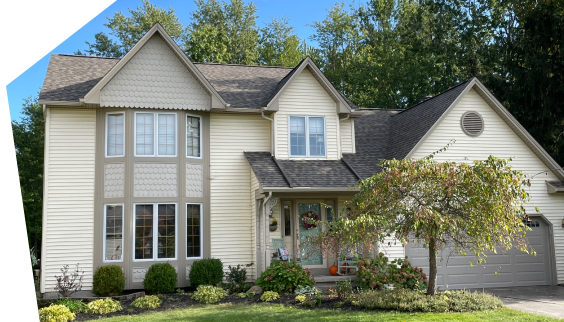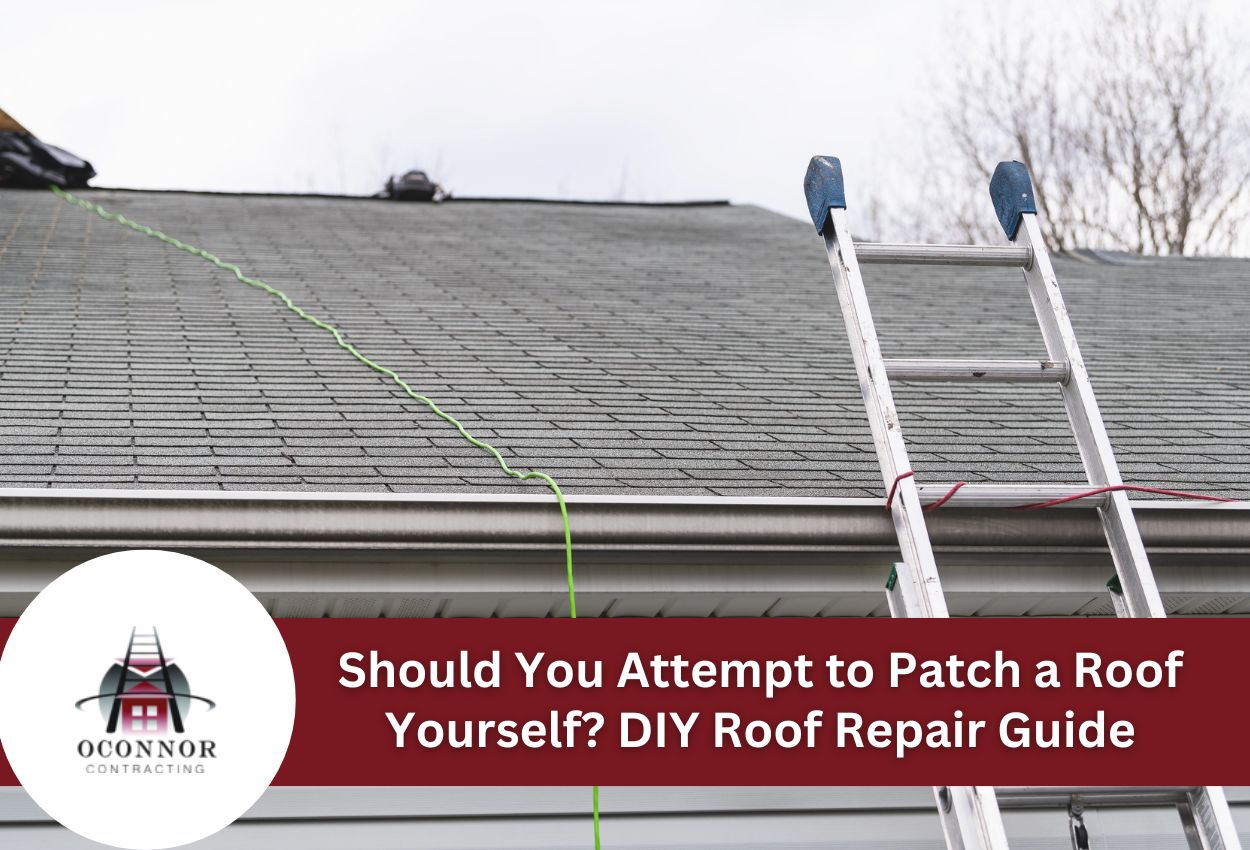When a roof leak appears, many Buffalo homeowners face an immediate decision: grab the ladder and materials to patch it themselves, or call a professional roofing contractor. This choice isn’t always straightforward, especially given Western New York’s challenging weather patterns that can quickly aggregate minor damage.
Some roof repairs are manageable for handy homeowners with the right tools and knowledge. Simple tasks like replacing a few damaged shingles or applying sealant to small cracks might fall within a homeowner’s capabilities. However, other situations demand professional expertise, particularly when safety risks are high or when the damage extends beyond what’s visible to the untrained eye.
The distinction between appropriate DIY fixes and repairs that require professional attention often comes down to several factors: the extent of damage, roof pitch and accessibility, material types, and your personal experience with home repairs. Buffalo’s freeze-thaw cycles and heavy snow create challenges that make some repairs especially tricky for amateurs.
Incorrect repair techniques can lead to more extensive damage, void warranties, or create dangerous situations. Understanding these boundaries isn’t just about saving money — it’s about protecting your home and personal safety.
Assessing Your Roof Damage: Can You Really Handle It?
Before climbing onto your roof with repair supplies, it’s crucial to accurately assess the extent of your damage. Not all roof problems are created equal, and misjudging the severity can lead to wasted time and potentially more extensive damage.
Minor issues that might be suitable for DIY repair include replacing a few loose or damaged shingles, small cracks that need sealant, or minor flashing repairs. These typically require basic tools and materials that most hardware stores in Buffalo carry. However, if you notice sagging areas, multiple missing shingles, or water stains spreading across your ceiling, these are red flags indicating more serious problems.
The type of roofing material on your home also impacts repair difficulty. Asphalt shingles, common throughout Buffalo neighborhoods, are relatively DIY-friendly for small patches. However, metal, slate, or cedar shake roofs require specialized knowledge and tools that most homeowners don’t possess. Working with these materials without proper experience can result in further damage or improper sealing that won’t stand up to Buffalo’s harsh winter conditions.
Remember that a roof damage assessment involves more than what’s visible from ground level. Underlying issues like deteriorated decking or compromised structural elements might be present without obvious external signs. Professional roofers have the training to spot these hidden problems before they become catastrophic failures requiring complete roof replacement.
Essential Tools and Materials for DIY Roof Patching
If you’ve assessed your roof damage and determined it’s suitable for a DIY fix, the right equipment is necessary for both safety and effectiveness. Start with safety gear: a sturdy extension ladder with stabilizers, non-slip footwear, a safety harness for steeper roofs, heavy-duty gloves, and eye protection. Never underestimate safety equipment when working at height, especially on Buffalo’s often wet or icy roofs.
For basic repairs, you’ll need a roofing hammer, pry bar, utility knife, caulk gun, and measuring tape. A good quality roofing nailer can save time and effort if you’re replacing multiple shingles. Don’t forget tarps to protect the surrounding areas and collect debris during your work.
Choosing the right materials is where many DIY repairs succeed or fail. For asphalt shingle replacement, make sure to match your existing shingles in both color and composition. Consider bringing a sample to your local hardware store for correct matching. Buffalo’s extreme temperature fluctuations necessitate high-quality roofing cement that remains flexible in cold weather. Look for products specifically rated for our northern climate with freeze-thaw resistance.
For flashing repairs, aluminum or galvanized steel options work well in our region. Ice and water shield membranes are essential for leak-prone areas, particularly along eaves where ice dams commonly form during Buffalo winters. Quality materials might cost more initially, but will prevent repeated repairs after harsh weather.
Safety First: Precautions for Homeowner Roof Work
Working on your roof involves significant risks that require serious safety measures, especially in Buffalo’s variable weather conditions. Before ascending your ladder, check the forecast — avoid roof work during rain, snow, high winds, or extreme temperatures, which are common in Western New York. Even morning dew can make shingles dangerously slippery.
Proper ladder setup is non-negotiable. Position your extension ladder on level ground, extend it at least 3 feet above the roof edge, and secure it at both top and bottom. Never place ladders near power lines — electrocution risks are often overlooked but extremely dangerous. Always maintain three points of contact while climbing.
For pitched roofs, invest in fall protection equipment including a safety harness anchored to a secure point. Roof brackets and planks create safer working platforms on steeper slopes. Wear non-slip footwear with good traction, heavy-duty gloves, and eye protection against flying debris.
Never work alone on a roof. Have someone nearby to stabilize your ladder, hand up tools, and call for help if needed. Before walking on your roof, assess its structural integrity. Soft spots could indicate rotted decking that won’t support your weight. Buffalo’s heavy snow can compromise roof structures in ways that aren’t immediately visible.
Remember, no roof repair is worth risking your safety. When in doubt about access or stability, professional roofers have specialized equipment and training to handle these challenges safely.
When to Call Professional Roofers: Red Flags for Homeowners
While minor repairs might be manageable for DIY-inclined homeowners, certain roofing issues need professional attention. If you notice sagging areas or dips in your roofline, this indicates structural damage that requires immediate professional assessment. These problems often stem from water damage to support beams or roof decking, which are issues that extend far beyond a simple patch job.
Multiple or persistent leaks, especially after attempted DIY repairs, suggest complex underlying problems that professionals are better equipped to diagnose. Buffalo’s challenging weather patterns often create hidden water pathways that can be difficult to trace without specialized equipment. Additionally, any repair that would require removing large sections of roofing material should be left to professionals, as improper reinstallation can void manufacturer warranties and lead to premature failure.
Timing is critical in Buffalo’s climate. Roof problems discovered in the fall should be addressed immediately before winter arrives. Ice dams and heavy snow can transform minor issues into structural damage within a single season. Professional roofers can quickly identify and repair vulnerable areas before secondary damage occurs to insulation, drywall, and electrical systems.
Remember that insurance considerations also come into play. Many homeowners insurance policies require certain repairs to be performed by licensed contractors. When damage might qualify for an insurance claim, professional documentation and repairs become even more essential.
Step-by-Step Guide: Tackling Minor Roof Repairs Safely
When you’ve identified a minor roof issue that falls within your DIY capabilities, following the right steps can make the difference between a successful repair and further complications. Before beginning any roof work in Buffalo, gather all the materials and tools you need so you won’t need to repeatedly climb up and down your ladder, which is when many accidents occur.
If you need to replace damaged shingles, start by lifting the edges of nearby shingles using a pry bar. Remove the nails holding the damaged shingle in place with your hammer’s claw, then slide out the old shingle. Insert the new shingle into position, secure it with roofing nails, and seal the edges with roofing cement. In Buffalo’s climate, apply extra sealant along the upper edge to prevent wind-driven rain and snow from penetrating underneath.
Small leak repairs often start with locating compromised flashing, which is installed around chimneys, vents, and valleys. Clean the area thoroughly before applying new roofing cement or replacing damaged flashing. Given our region’s freeze-thaw cycles, ensure all repairs maintain proper water runoff patterns to prevent ice damming in the winter.
After completing repairs, test your work by spraying water above the repaired area and checking for leaks from inside your attic. Common challenges include improper nail placement or inadequate sealing. Remember that Buffalo’s harsh winters will quickly expose any weaknesses in your repair work, so thoroughness is essential for lasting results.
Long-Term Considerations: DIY Patching vs. Professional Repairs
While DIY roof patching might save money upfront, Buffalo homeowners should carefully consider the long-term implications of these temporary fixes. Amateur repairs often address only visible symptoms rather than underlying problems, potentially allowing water infiltration to continue damaging structural elements. Over time, this can reduce your roof’s expected lifespan, particularly in Buffalo, where our seasonal weather already stresses roofing materials.
Home resale value is another important consideration. Prospective buyers typically hire inspectors who can easily identify amateur repairs. Poorly executed patches may raise red flags about other potential maintenance issues, potentially lowering offers or complicating sales. Professional repairs, though initially more expensive, often include workmanship warranties that can transfer to new owners, which is an attractive selling point in Western New York’s competitive real estate market.
A sustainable approach to roof maintenance combines homeowner vigilance with professional expertise. Consider developing a relationship with a reputable Buffalo roofing contractor who can perform annual inspections, including after severe weather events. Between these professional checkups, homeowners can safely handle basic maintenance like clearing debris and monitoring for visible damage from ground level.
This balanced strategy of addressing minor issues yourself while scheduling professional intervention for significant repairs maximizes roof longevity while managing costs. Given Buffalo’s extreme seasonal weather swings from summer heat to winter storms, this proactive approach protects your home far better than relying exclusively on DIY solutions or waiting until problems become severe enough to need emergency repairs.
Professional Roof Repairs in Buffalo, NY
If you’ve identified major issues such as structural damage, extensive leaking, or repairs that could impact your roof’s warranty, it’s time to contact a professional. In Buffalo, roofing problems require swift action to prevent further damage, especially during the harsh winter months. Don’t let a minor issue turn into a major headache. Call OConnor Contracting at (716) 600-7663 for expert roofing services that keep your home safe and secure. Trust the professionals to handle complex repairs that go beyond the scope of DIY. Remember, quick intervention by experts can save you from expensive repairs in the future.


